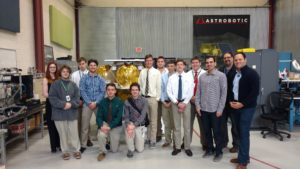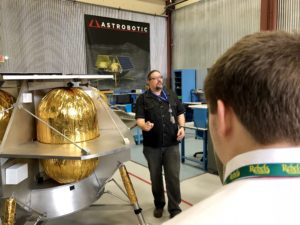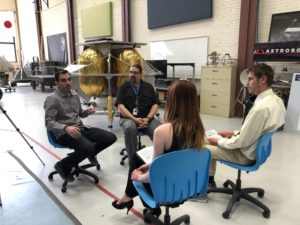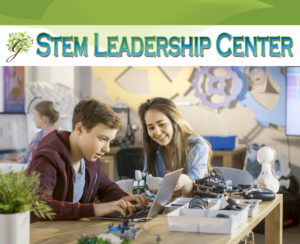 The moon had already set over Pittsburgh on the morning of Friday, March 2, as a robotics classroom from Seton LaSalle stepped inside the Pittsburgh office of Astrobotic. Eleven students and two teachers met the people slated to be “the FedEx to the moon.”
The moon had already set over Pittsburgh on the morning of Friday, March 2, as a robotics classroom from Seton LaSalle stepped inside the Pittsburgh office of Astrobotic. Eleven students and two teachers met the people slated to be “the FedEx to the moon.”
The future of education has been evolving. The acronym STEM encapsulates a new approach when a textbook (and a teacher’s education of “facts” are outdated by the exponential growth of information and exercise sets with their standardized tests built to support the incremental building of complex thought have crushed the desire to learn from the very students it sought to empower.
We still need texts and teachers and exercise sets, but STEM education provides propulsion to motivating students through the drudge of learning the basics and mastering the skills. It taps into the those three keys to human drive: autonomy, purpose, and mastery. It connects students with real world science and makes them a part of the missions that used to be mere dreams for when they finished years of drills and tests and certification check boxes. It makes a distant goal real and visceral, It has the side benefit of reinvigorating the technologists, engineers, and scientists that suffer through their own moments of discouragement and failure.
Seniors Gabrielle Hirsch and Ryan Winter dove deep into the Astrobotic website and news articles preparing interview questions to take place during their classroom visit. Their research fellowship goal is to engage the astronomy and robotics students of Seton LaSalle High School and get them excited enough to persevere the rigor of learning in STEM, while they help tackle real-world problems of space exploration. The two crafted questions and stole a few minutes with Propulsion Engineer Jeff Hopkins and Systems Engineer Ander Solorzano.

One of the students from Astronomy has been working on a science fair project about the environment on the moon and the difficulties encountered with the regolith (think soil) – sharp ground up meteorites, that create the dust on the surface and get into equipment. They ran into problems getting the regolith substitutions for the experiment and were amazed to find so much research into creating regolith simulant and the industry that has developed selling regolith simulant of both our moon and of Mars.
Another student listened in rapt attention to the redesigns of Astrobotic’s Peregrine lander to the measurements of how much the regolith will life off the surface when the lander touches down, Protecting the packages for delivery is a primary concern, so these measurement studies lead to real world engineering changes. He hopes his research will lead future students to pursue these experiments,
 Jeff Hopkins and I were able to talk as the kids took their pictures upstairs. He is also trying to inspire juniors and seniors at Robert Morris University in an engineering course he is teaching. Robert Morris is leading the way in innovative engineering education. Their offerings of manufacturing, software and logistics engineering have emerged out of partnerships with leading companies like PPG Industries, Westinghouse, American Home Improvement Products, Cutler Hammer, PGT Trucking, Bayer, J&L Speciality Steel, Mobay and others. These partnerships allow for students to get hands on experience solving the problems these companies are facing.
Jeff Hopkins and I were able to talk as the kids took their pictures upstairs. He is also trying to inspire juniors and seniors at Robert Morris University in an engineering course he is teaching. Robert Morris is leading the way in innovative engineering education. Their offerings of manufacturing, software and logistics engineering have emerged out of partnerships with leading companies like PPG Industries, Westinghouse, American Home Improvement Products, Cutler Hammer, PGT Trucking, Bayer, J&L Speciality Steel, Mobay and others. These partnerships allow for students to get hands on experience solving the problems these companies are facing.



